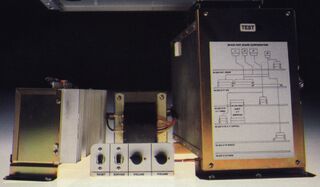Sega G80
From Sega Retro

| |||||||||||||||||
| Sega G80 | |||||||||||||||||
|---|---|---|---|---|---|---|---|---|---|---|---|---|---|---|---|---|---|
| Manufacturer: Sega | |||||||||||||||||
|
The Sega G80 is an arcade system produced by Sega in 1981. It can be considered a successor to the Sega VIC Dual system, and was Sega's arcade platform of choice before the release of the Sega System 1.
The Sega G80 platform provided a basis for many reasonably successful vector-based games from the company, some of which, such as Space Fury, Tac/Scan, and, perhaps most famously, Star Trek: Strategic Operations Simulator, saw home console/computer ports.
Contents
Hardware
The G80 was designed to be a more versatile system than those seen in arcade cabinets of the past. Rather than rely on bespoke cabinet designs for each game, Sega opted for a more cost-effective "Convert-a-Game" system (as it was marketed in the US), in which games housed on CPU boards could be easily swapped by arcade operators. Announced at Visions '81[2], Sega's plan was to be able to cut install times down to 15 minutes, while also minimising production costs and tackling the poor resale value of used games[2]. As a result, "ConvertaPaks" would cost less to buy than brand new cabinets[3] (about $1,000 USD each[1], versus the $3,000 Sega estimated the average arcade game to cost in 1981[4]).
The G80 system consists of a card cage with a 6 slot backplane that can be populated in different game configurations from a selection of 10+ different pluggable boards, allowing it to be configured as either a raster system if a raster video board is inserted, or a vector system that can display color vector graphics.
The G80 gets its name from its Z80 CPU which was coupled with a custom security chip to prevent operators from abusing the swappable system. The security chip would obfuscate the "ld (address),a" instruction (opcode 32h) differently based on the security chip installed — an early form of copy protection. The mangling algorithms are rather complicated, and differ from security chip to security chip.[5]
While Sega had high hopes for its "Convert-a-Game" system, only Sega produced games for it, and even then, big releases such as Pengo and Zaxxon used their own, bespoke hardware. More robust arcade standards would arrive in the years which followed - the JAMMA specifications from 1985/1986 are built around the same idea of swappable arcade PCBs, but do not tie developers down to specific hardware. It is mainly the input and output connectors that are standardised instead.
Space Odyssey was the first game to use this system, followed by Space Fury[2].
Technical specifications
- Sega USB (Universal Sound Board)
- MCU: Intel i8035 @ 3.12 MHz (8-bit instructions, 3.12 MIPS, 1 instruction per cycle)
- Sound chip: Sega Melody Generator (programmable sound generator)
- Speech Board (optional)
- MCU: Intel i8035/i8039 @ 3.12 MHz (8-bit instructions, 3.12 MIPS)
- Speech synthesizer: General Instrument SP0250 (linear predictive coding)
- Sega System 1 sound board (optional, used for Sindbad Mystery in 1983)
- Sound chips: Sega SN76496 @ 4 MHz, Sega SN76496 @ 2 MHz
- Raster graphics board: Sega Video I[5]
- Raster display controller: Sega Raster Display Controller @ 15.468 MHz
- Video resolution:
- Horizontal: 256×224 (display), 328×262 (overscan)
- Vertical: 224×256 (display), 262×328 (overscan)[7]
- Color palette table: 256 (8-bit RGB PROM)
- Colors on screen: 64 to 128 (palette RAM)
- Tilemap planes: 2 layers, horizontal and vertical scrolling,[7] 8×8 tiles, 4 colors per tile
- Sprite capabilities: 28 to 32 sprites per scanline, 224 to 256 sprite pixels/texels per scanline, 4 colors per sprite, 8×8 to 16×16 sizes[6]
- Vector display controller: Sega Display Controller[8]
- Color depth: 64 (6-bit RGB)[9]
List of games
Raster
- 005 (1981)
- Astro Blaster (1981)
- Space Odyssey (1981)
- Monster Bash (1982)
- Pig Newton (1983)
- Sindbad Mystery (1983)
Vector
- Space Fury (1981)
- Eliminator (1981)
- Battle Star (1982)
- Star Trek: Strategic Operations Simulator (1982)
- Tac/Scan (1982)
- Zektor (1982)
Promotional material
References
- ↑ 1.0 1.1 File:ConvertaGames Arcade US Flyer.pdf, page 2
- ↑ 2.0 2.1 2.2 Cash Box, "July 4, 1981 (Part 2 of 2)" (US; 1981-07-04), page 57
- ↑ Cash Box, "July 4, 1981 (Part 2 of 2)" (US; 1981-07-04), page 58
- ↑ File:ConvertaGame Arcade US Flyer.pdf, page 2
- ↑ 5.0 5.1 5.2 5.3 Sega G-80 raster hardware (MAME)
- ↑ 6.0 6.1 6.2 6.3 Sega G80 Hardware Reference (1997-10-25)
- ↑ 7.0 7.1 Sega G-80 raster video hardware (MAME)
- ↑ Sega G-80 vector hardware (MAME)
- ↑ Sega G-80 vector video hardware (MAME)
| Sega arcade boards |
|---|
| Originating in arcades |
|
77
78
79
80
81
82
83
84
85
86
87
88
89
90
91
92
93
94
95
96
97
98
99
|
| Console-based hardware |
|
84
85
86
87
88
89
90
91
92
93
94
95
96
97
98
99
00
01
02
03
04
05
06
07
08
09
10
11
12
13
14
|
| PC-based hardware |
|
05
06
07
08
09
10
11
12
13
14
15
16
17
18
19
20
21
22
23
|

